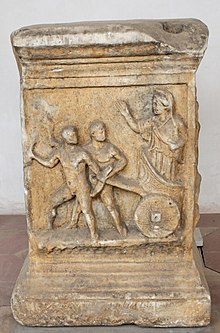Kleobis and Biton

Cleobis and Biton ( Greek Κλέοβις and Βίτων ) were a pair of brothers in Greek mythology , sons of Kydippe, a priestess of Hera in Argos .
myth
The two brothers only had the bare essentials for life, but were endowed with immense physical strength (ῥώμη σώματος), which means they won many prizes in fighting games. They were connected by extraordinary brotherly love and were known for absolute, dutiful obedience to their mother.
When Kydippe had to be driven to the temple on the occasion of a festival of sacrifice in honor of Hera in Argos, but the draft oxen for the two-team had not yet returned from the field, the brothers placed themselves under the yoke and pulled the wagon themselves through the forty-five stages to the sanctuary. There both of them lay down in the temple to rest after the sacrificial meal, completely exhausted from the exertion and strain of the long journey, and fell asleep. Kydippe, proud of her well-off sons, prayed to Hera and asked her sons to be thanked for the best that a person could receive, whereupon they did not wake up again, but fell asleep gently and so, still standing in youth and beauty, one received quick and gentle death. In this way the gods showed the two young men their special favor and grace ("... dies young, whom the gods love ...").
The Argives later had statues erected by them, consecrated them in Delphi and praised Cleobis and Biton as symbols of the highest virtue.
Statues

Two statues of Cleobis and Biton were found in Delphi , Statue 1 (A) 1893 northwest of the Treasury of the Athenians and Statue 2 (B) 1894 about 10 m west of A.
Inscriptions on the pedestals identify the statues as Cleobis and Biton and - which is rather unusual - also the sculptor, [Poly] mides from Argos. The two-line inscription begins at the top left on base B and continues at the top right on base A (quotations from the inscriptions based on Kouroi by Gisela Richter).
Base B
[κλεοβις και βι] τον | ταν ματαρα - - - - - ς hι | - - - - - - - -
Base A
Εαγαγον τοι δ΄ υιοι [] μεδες εποιεε hαργειος
The statues are not completely identical. A seems longer and B rather wider. It doesn't have to be wanted; Since all the statues were carved out of the stone by hand, no identical copies were possible. Which of the two represents Cleobis and which Biton cannot be determined.
The torsos are square as in the Sounion-Kouros , but Cleobis and Biton have more rounded shapes, which suggests a later date of origin (around 580 BC). However, some anatomical details are still only notched into the surface.
The arms and lower legs are rounder. The kouroi have broad shoulders and a short waist . The upper arm is short.
"The contrast between strong legs and the conical trunk growing out of them appears ancient, a contrast that was already overcome with the Sounion Group."
The head is cubic in shape and flat on the top and back. The face is broad with a deep, receding forehead . The ears are in the anatomically correct place. The nose is broad and short. The early archaic eye shape has been abandoned. The spherically arched eyeballs are framed by mirror-inverted, taut lids that taper at the angles. The hair falls down the back in six braids and in three braids at the front on each side.
swell
- Herodotus , Histories , I / 31
literature
- Johannes Toepffer : Biton 1 . In: Paulys Realencyclopadie der classischen Antiquity Science (RE). Volume III, 1, Stuttgart 1897, Col. 544 f.
- Detlev Kreikenbom : Mature archaic sculpture . In: The History of Ancient Sculpture . Edited by Peter C. Bol , Vol. I: Frühgriechische Plastik , Mainz 2002.
- Gisela MA Richter : Kouroi. Archaic Greek Youths. A study of the development of the Kouros type in Greek Sculpture . Phaidon Press, London 1960.
Comments or sources
- ↑ Ancient Greek measure of length, corresponds to 600 feet, depending on the regional foot measure between approx. 157 and 211m
- ↑ Cf. Gisela Richter: Kouroi. Archaic Greek Youths. A study of the development of the Kouros type in Greek Sculpture. London: Phaidon Press, 1960, p. 128
- ↑ Detlev Kreikenbom: Reifarchaische Plastik. In: The History of Ancient Sculpture. Edited by Peter C. Bol, Vol. I. Frühgriechische Plastik, Mainz 2002, p. 145